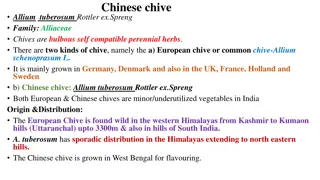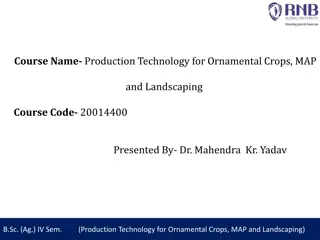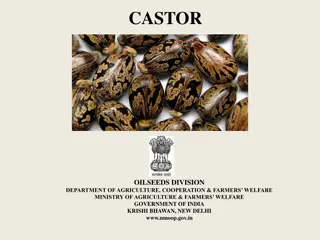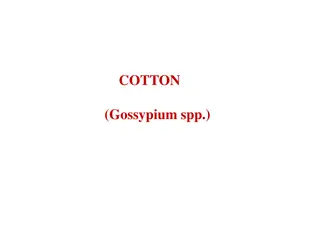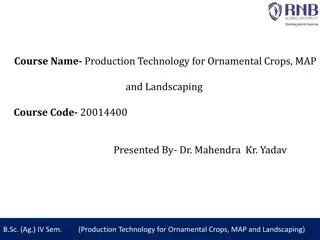All About Jute: Cultivation, Properties, and Uses
Jute, a versatile fibre plant cultivated in India for over 5000 years, is known for its coarse, strong, and biodegradable fibres. This presentation explores the journey of jute from plant to fabric, emphasizing the importance of cultivation, soil and weather requirements, and top jute-producing states in India. Learn about the process of obtaining jute, its uses in various industries, and key characteristics that make it a valuable material.
Download Presentation

Please find below an Image/Link to download the presentation.
The content on the website is provided AS IS for your information and personal use only. It may not be sold, licensed, or shared on other websites without obtaining consent from the author.If you encounter any issues during the download, it is possible that the publisher has removed the file from their server.
You are allowed to download the files provided on this website for personal or commercial use, subject to the condition that they are used lawfully. All files are the property of their respective owners.
The content on the website is provided AS IS for your information and personal use only. It may not be sold, licensed, or shared on other websites without obtaining consent from the author.
E N D
Presentation Transcript
Fibre to Fabric-PPT-5 Prasanta Choudhury
Specific Aim To know the Meaning and Importance of Cultivation, The journey of Jute from Jute plant to fibre, Nature of land and Climate required etc.
Questions And Answers Question: Mention few advantages of Cotton Answer: Cotton absorbs sweat and keeps the body cool in summer. Answer: Cotton is strong and easy to wash and dry. Question: Mention a disadvantage of Cotton fibre. Answer: Cotton wrinkles easily and does not dye as easily as other fabrics. Question: Name any other fabric obtained from plant. Answer: Jute
Some Questions And Answers Question: What type of Soil does Jute require? Answer: June grows well in well- watered alluvial Soils Question: What type of Weather does Jute require? Answer: Jute needs hot and humid climate and moderate rainfall. Question: Which part of the Jute plant yield Jute fabric? Answer: Stem
Introduction You know cadets; Jute is a fibre plant that has been grown in India for over 5000 years. Jute fibres are coarse, strong and biodegradable. Jute fibres are golden in colour. Today we shall discuss about Jute!
Important Points Jute: Nature of soil Jute grows well alluvial soil. Nature of Weather Jute needs hot and humid climate and moderate rainfall. Cotton yielding states West Bengal, Bihar, Assam, Odisha and Tripura are the top producers of Jute in India.
Important Points Obtaining Jute The Jute plants grow to around 3m in height. The stems of the Jute plants are cut down and tied into bundled. The bundles are placed in shallow running water and allowed to rot. Retting The process of letting the jute stems rot in water to loosen the jute fibres is called retting. The Jute fibres are separated, softened and dried before they are used. India is the largest producer of Jute in the world. Uses: Jute is used to make gunny sacks, rugs, mats, carpets. Jute is also used to make clothes, bags, Footwear and Jewellery.
Some Questions & Answers Question: What type of Soil does Jute require? Answer: Jute grows well in alluvial soil. Question: What type of Weather does Jute require? Answer: Jute needs Hot and Humid climate and Moderate rainfall. Question: Name top Jute producing states of India. Answer: West Bengal, Bihar, Assam, Odisha and Tripura are the top producers of Jute in India.
Some Questions & Answers Question: What is Retting? Answer: The process of letting the jute stems rot in water to loosen the jute fibres is called retting. Question: Mention few uses of Jute fibre. Answer: Jute is used to make gunny sacks, rugs, mats, carpets. Jute is also used to make clothes, bags, Footwear and Jewellery. Question: Which part of the Jute plant yield Jute fibre? Answer: The stem of the Jute plant yield Jute fibre.
Question? Question: Describe how we get Jute fibres from the Jute plant. Answer: The Jute plants grow to around 3m in height. The stems of the Jute plants are cut down and tied into bundled. The bundles are placed in shallow running water and allowed to rot. The Jute fibres are separated, softened and dried before they are used.









